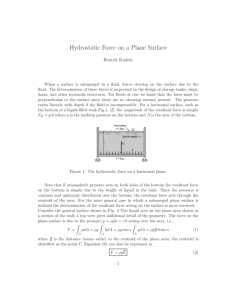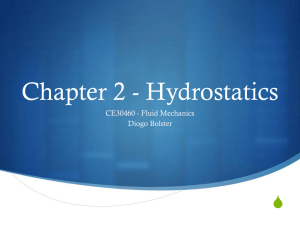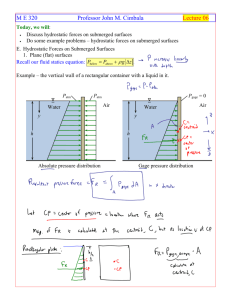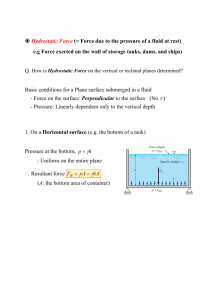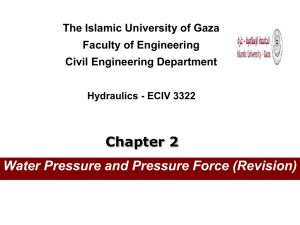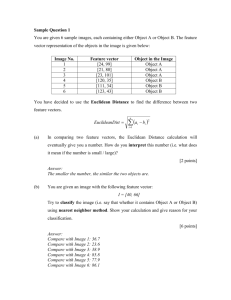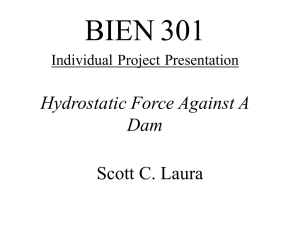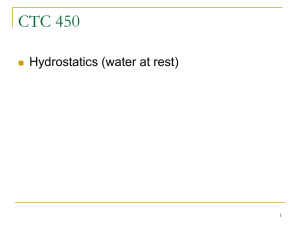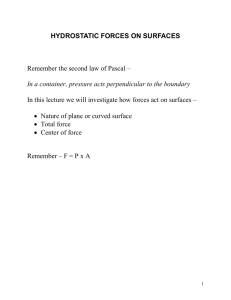Lecture 3
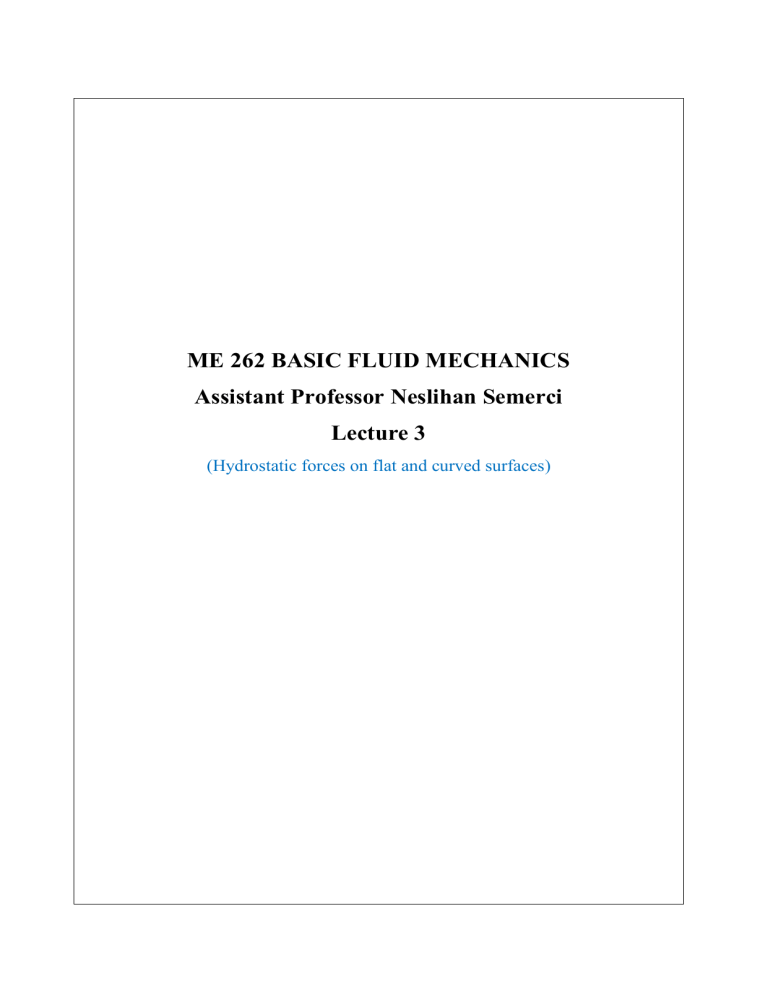
ME 262 BASIC FLUID MECHANICS
Assistant Professor Neslihan Semerci
Lecture 3
(Hydrostatic forces on flat and curved surfaces)
15. HYDROSTATIC PRESSURE
15.1 Hydrostatic pressure force on flat surfaces
When a liquid is contained by a surface such as a dam, the side of the ship, a water tank, it is necessary to calculate the force and its location due to the liquid. Assume that a plane AB is made up of an infinite number of horizontal strips, each having a width of dy and an area of dA.
The hydrostatic pressure on each strip may be considered constant because the width of the strip is very small.
For a strip at depth “h” below the free surface
P =
γ liquid h
=
y sin
The total force on the strip is the pressure times the area dF=
y sin
dA
The total pressure force over the entire AB plane surface is the sum of pressure on all strips.
F =
∫ dF = ∫ γy sin θ dA = γ sin θ ∫ ydA
F=
γ sin θAy̅
Total area
𝑦̅ =
distance measured from the x-axis to the centroid ( or the center of gravity ) of the AB plane.
F =
γh
A
TOTAL HYDROSTATIC PRESSURE FORCE ON ANY SUBMERGED PLANE SURFACE
IS EQUAL TO THE PRODUCT OF THE SURFACE AREA AND THE PRESSURE
ACTING AT THE CENTROID OF THE PLANE SURFACE.
Pressure forces acting on a plane surface are distributed over every part of the surface. They are parallel and act in a direction normal to the surface. These parallel forces can be analytically replaced by a single resultant force (F
R
).
The resultant force acts normal to the surface. The point on the plane surface at which the resultant force acts is known as the center of pressure (C.P.). To determine this point, the sum of moments of all infinitesimal forces must be equal to the moment of resultant forces.
Fy
P
= ∫ ydF
A
Fy
P
= ∫ y ⏟
A dF y
P
=
∫ ydF
F y
P
=
∫ yγySinθdA
γSinθAy y
P
=
∫ y 2
Ay̅ dA
2 dA = I x
Moment of inertia with respect to x-axis
A × y̅ = M x
static moment of the plane with respect to x-axis y
P
=
I x
M x
With respect to centroid of the plane surface; y
P
=
I
0
+Ay̅ 2
Ay̅
=
I
0
Ay̅
+ y̅
I
0
=
Moment of inertia of the plane with respect to its own centroid (center of gravity)
NOTE: THE CENTER OF PRESSURE OF ANY SUBMERGED PLANE SURFACE IS
ALWAYS BELOW THE CENTROID OF THE SURFACE AREA .
Example 15.1.(Hwang et al., 4 th
Edition) A vertical trapezoidal gate with its upper edge located 5 m below the free surface of water is shown in Figure 15.1. Determine the total pressure force and center of pressure on the gate.
Figure 15.1
Total Pressure Force
F = γ h̅A
From Table 2.1 centroid of the trapezoidal surface y̅
and the vertical distance of the centroid below the water surface ( h̅)
are calculated as follows: h̅ = h + y̅ = h + h(2a + b)
3(a + b) h̅ = 5 +
2(2x1 + 3)
3(1 + 3) h̅
= 5.83 m
Area of the trapezoidal surface;
A = h(a+b)
2
A =
2(1+3)
2
= 4 m 2
F = γh̅A = 9.79(5.83)(4 m 2 )
F = 228 kN
Moment of Inertia for trapezoidal surface;
I
0
= h
3
(a
2
+4ab+b
2
36(a+b)
)
= 1.22 m 4
The location of the center of pressure; y
P
=
I
0
Ay̅
+y̅ =
1.22
4(5.83)
+ 5.83 y
P = 5.88 m below the water surface
Example 15.2 (Hwang et al., 4 th
Edition): An inverted semicircular gate is installed at 45
℃ with respect to the free water surface (Figure 15.2).The top of the gate is 5 ft below the water surface in the vertical direction. Determine the hydrostatic force and the center of pressure on the gate.
Figure 15.2
Total pressure force :
γ × h̅ × A
=
γy̅ sin θ A
A =
1
2
π (4) 2 = 25.1 ft 2
4r y̅ =
3π
+
5 sin 45
=
4(4)
3(3.14)
+
5
√2
⁄
2
=
8.77 ft
Total pressure force=
γy̅ sin θ A
= (62.3
Ib ft 3
) (8.77)(sin 45)(25.1 ft 2 )
= 9700 Ibs
Location of center of pressure: y
P
=
I
0
Ay̅
+y̅
I
0
=
(9π 2 −64)r 4
72 π y
P
=
25.1 ft
28.1 ft 4
2 × (8.77 ft)
+ 8.77 ft y
P = 8.90 ft (Inclined distance measured from the water surface to the center of pressure)
Procedure for computing force on a submerged area
1.
Identify the point where the angle of inclination of the area intersects the level of the free surface of liquid.
2.
Locate the centroid ( center of gravity ). Use table 2.1.
3.
Determine ℎ̅ =
vertical distance from the level of the free surface to the centroid of the area.
4.
Determine 𝑦̅
as the inclined distance from the level of the free surface down to the centroid area.
5.
Calculate total area on which the force is to be determined
6.
Calculate resultant force
F
K
= γhA
7.
Calculate,
I
0 , moment of inertia of the area about its centroidal axis.
8.
Calculate the location of the center of pressure, y
P
= y +
I
0
Ay̅
9.
Sketch the resultant force acting at the center of pressure perpendicular to the area.
15.2 Hydrostatic pressure force on curved surfaces
Hydrostatic force on curved surface can be analyzed best by resolving the total pressure force on the surface into its horizontal & vertical components.
Static
=>
Equilibrium
∑ F
∑ F
X y
= 0
= 0
Because the water body in the container is stationary.
Each of the force components must satisfy the equilibrium conditions.
In the free body diagram of the water contained in ABA’ equilibrium requires the horizontal pressure exerted on plane surface A'B (the vertical projection of AB) to be equal and opposite the horizontal pressure component F
H
(the force that gate wall exerts on the fluid).
∑ F
X
= F
A ′ B
− F
H
= 0
F
H
=F
A'B
Force gate exerts on the liquid
∑ F y
= F
V
− (W
AA ′
+ W
ABA ′
) = 0
F
V
= W
AA ′
+ W
ABA ′
Horizontal component of the hydrostatic pressure force = Pressure force on the vertical projection of the surface. y
P = Location of resultant force y
P
=
I
0
A×y̅
+y̅
Vertical component of the hydrostatic pressure force = Weight of the entire water column above the surface extending vertically to the free surface.
Location of
𝐹
𝑉
=
It’s located through the centroid ( center of gravity ) of water column.
F
R
= √F
H
2 + F
V
2 direction = tan −1 (
F
V
F
H
)
Example 15.3
Figure 15.3
Determine the total hydrostatic pressure and center of pressure on the 5 m long, 2 m high quadrant gate.
Horizontal component is equal to the hydrostatic pressure force on the projection plane A'B. h̅ = h
2
=
2 m
2
=
1 m
Area = (5 m x 2 m ) = 10 m 2
F
H
= γh̅A
F
H
= (9.79 kN/m 3 )(1)(10 m 2 )
F
H
= 97.9 kN
Location of the force
→ F
H
→ y
P
=
I
0
Ay̅
+ y̅
I
0
1
=
12 bh 3
I
0
1
=
12
(5)(2) 3
I
0
=
3.33 m 4 h = y, h̅ = y̅ y
P
=
3.33
10(1)
+1 = 1.33 m
Vertical component = weight of the water in the volume AOB
F
V
= γAh
F
V
= (9.79)
(
1
4
π
(
2 m
) 2
)(5 m)
F
V
= 154 kN
The pressure is located at the centroid. From table 2.1 (Semicircle) y̅ =
4r
3π
=
4(2 m)
3(3.14)
= 0.85 m
F
R
= √F 2
H
+ F 2
V
F
R
= √97.9
2 + 154 2 = 182 kN
θ = tan −1 (
F
V
F
H
) = (
154
97.9
) => 57.6°
Example 15.3 Water tank filled with water. Determine the horizontal and vertical components of the resultant force on the curved surface.
w = 2.5 m
,
γ = 9.81
, r = 1.5 m d
1
= 3.0 m d
2
=4.5 m
Curved surface
2.5 m
Vertical component = Weight of the isolate volume
Area =
A
1
+ A
2
= (3 mx1.5) +
(
1
4
× π × (1.5) 2
)
Area =
6.267 m 2
Volume = Area
× h = 6.267 × 2.5 m = 15.67 m 3
width of the tank
Weight =
γ × ∀
=
(9.81) × (15.67 m 3 ) = 153.7 kN
F
V
= 153.7 kN
Vertical force component acting upward through the centroid of the volume.
The location of the centroid is found using the composite area technique.
X1=0.75 m
X
1
=
1
2 b
=
1
2
(1.5 m)= 0.75 m
3.0 m
X=0.72 m
X
2
=
4
3 r
π
=
4
3
( 1.5
)
( 3.14
)
= 0.64 m
1.5 m
X
2= 0.64 m
X̅ =
A
1
×X
1
+A
2
×X
2
A
1
+A
2
=
(4.5)(0.75)+(1.767)(0.64)
4.5+1.767
X̅
= 0.72 m
Vertical projection of the curved surface
The depth of the centroid of the projected area
1.5 m 1.5 m ℎ = ℎ + 𝑦 = 3 +
1.5 𝑚
2
=
3.75 m
F
H
= 𝛾(𝐴𝑟𝑒𝑎)ℎ = (9.81)(2.5)(1.5)(3.75𝑚)
2.5 m
F
H
=138 kN
The depth of the line of action of the horizontal component
Depth of line of action, y
P y
P
=
I
0
Ay̅
+y̅
I
0
=
1
12 bh 3
1
=
12
(2.5)(1.5) 3 y
P
=
(
1
12
)×(2.5)×(1.5) 3
(2.5)×(1.5)×(3.75)
+3.75
=3.80 m
Resultant force ,
F
R
= √F 2
V
+ F 2
H
F
R
=
√(153.7) 2 + (138) 2
F
R
= 206.5 kN
θ = tan −1 (
F
F
V
H
) = tan −1 (
153.7
138
) = 48.1°

